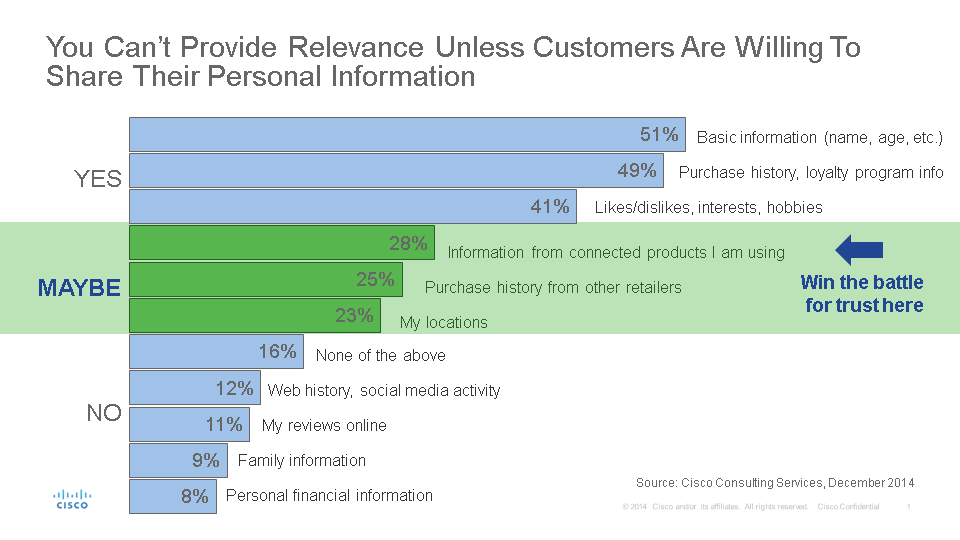As Cisco’s chief marketing officer, an important part of my role is to build and maintain the trust of Cisco’s customers.In fact, “brand promise” ultimately relies upon the trust consumers have placed in a brand. Customers who are loyal to a brand will trust that the next product or service introduced under that brand will fulfill the brand promise. However, trust can also have more widespread impacts that affect an organization’s ability to compete and to provide the innovative customer experiences required in the Internet of Everything (IoE) era.
This week at the National Retail Federation’s “Big Show” in New York, Cisco released a new study that uncovered some unique insights about shopping behaviors and attitudes among U.S. and U.K. consumers in the digital age. The findings point to the need for retailers to provide “hyper-relevant” shopping experiences that deliver value to the consumer in real time throughout the shopping lifecycle. Hyper-relevance comes with the ability to dynamically compare real-time customer information with historical data, and the resulting insights allow retailers to improve operations and the customer experience. At stake, according to our research, is an estimated profit improvement of 15.6 percent for an illustrative $20 billion retailer that builds agile business processes for turning these insights into value.
Our research shows that consumers are looking for retailers to deliver hyper-relevance via three value proposition categories: efficiency, engagement, and savings. In the area of efficiency, for example, 77 percent of respondents said they would be “somewhat” or “very likely” to use a solution to optimize the checkout process. In terms of savings, 79 percent indicated a willingness to take advantage of in-store offers provided via digital signage, while 73 percent said they’d like to receive special offers through augmented-reality solutions. And, in the area of engagement, 57 percent indicated a desire to learn more about products in the store by using augmented-reality capabilities.
One of the points I found particularly interesting is that consumers are relatively willing to provide certain types of personal information to retailers—such as name, age, past purchasing history, interests, and hobbies—in order to get a more personally relevant shopping experience. But beyond this basic information, there is a “trust cliff,” a steep drop-off in willingness to share certain types of personal information. A significant 16 percent of respondents were not willing to share any personal information at all.
This trust cliff presents an interesting conundrum for retailers. On one hand, our study shows that customers want personalized and contextually relevant shopping experiences. But on the other hand, they are reluctant to share the very information that can help provide these “hyper-relevant” experiences.
Retailers Must Focus on the Middle of the “Trust Cliff”: You Can’t Provide Relevance Unless Customers Are Willing To Share Their Personal Information.

Source: Cisco Consulting Services, December 2015
It is clear that a large majority of consumers will never feel comfortable sharing social media activity and family or financial information, where “willingness to share” hovers at around 10 percent. But a quarter of consumers are open to sharing their location, purchase history from other retailers, and information generated by connected products they are using. It is here, in the middle of the “trust cliff,” that retailers can prove themselves trustworthy, enabling them to then deliver a more personalized shopping experience for those consumers.
One way to earn consumers’ trust is to be completely transparent about what information is being collected, how it is being used, and what the consumer benefit is. When consumers use a retailer’s shopping app or “opt in” to use the in-store Wi-Fi, there shouldn’t be any surprises other than their surprised delight in a smooth, efficient, hyper-relevant shopping experience.
Many retailers use their Wi-Fi networks to track shoppers as they move through the store. This can be intrusive if the location data is used to send the shopper unwanted promotional messages. But suppose in-store analytics could detect a shopper moving very rapidly through the store and identify that person as someone who is in a hurry? That person could then be flagged to not receive special promotions – just a message identifying the shortest checkout line.
Consumers will be much more willing to share information if they are sure their privacy will be treated with respect. Seventy-four percent of survey respondents said they would be somewhat or much more accepting of retailers tracking in-store behavior if it were “anonymized” so it could not be linked directly to them. Even when not identified with a specific consumer, this information can be tremendously valuable to retailers who use in-store analytics to help improve traffic flow, place product displays more effectively, offer spontaneous promotions and optimize checkout lines. (Check out my recent blog on the “Museum of Lasts.” As we make more connections creating more insights, we can solve problems big and small, including “The Last Checkout Line”.)
Retail competitive dynamics in the next five years will be governed by who wins permission from consumers to leverage the data at the middle of the trust cliff. This data will be the lifeblood of the Internet-of-Everything-enabled solutions — such as proximity marketing, targeted promotions, and in-store analytics — that will ultimately deliver hyper-relevance to consumers, while making retailers more profitable.


Great post! Thank you for sharing.
Amazing work done. I am glad that you shared this. I will surely share it with all my acquaintances.
Wow this is good work and nice post
thank for your sharing
Not sure I like the idea of them tracking me thru the store; but if they do, I love the idea of not sending promos to peeps who are in a hurry. K.T.
A pretty radical look at shopping in a store but then that is what technology is doing to our world today. Change and innovation is the new mantra and in these seamless technologically turbulent times one can depend on Cisco to show the way forward. Ordered and deliberate disruption but with a set pattern does strike a chord! Great read and very engaging style.